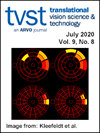
Translational Vision Science & Technology
TRANSL VIS SCI TECHN
期刊介绍
Translational Vision Science & Technology (TVST), an official journal of the Association for Research in Vision and Ophthalmology (ARVO), an international organization whose purpose is to advance research worldwide into understanding the visual system and preventing, treating and curing its disorders, is an online, open access, peer-reviewed journal emphasizing multidisciplinary research that bridges the gap between basic research and clinical care. A highly qualified and diverse group of Associate Editors and Editorial Board Members is led by Editor-in-Chief Marco Zarbin, MD, PhD, FARVO.The journal covers a broad spectrum of work, including but not limited to:Applications of stem cell technology for regenerative medicine,Development of new animal models of human diseases,Tissue bioengineering,Chemical engineering to improve virus-based gene delivery,Nanotechnology for drug delivery,Design and synthesis of artificial extracellular matrices,Development of a true microsurgical operating environment,Refining data analysis algorithms to improve in vivo imaging technology,Results of Phase 1 clinical trials,Reverse translational ("bedside to bench") research.TVST seeks manuscripts from scientists and clinicians with diverse backgrounds ranging from basic chemistry to ophthalmic surgery that will advance or change the way we understand and/or treat vision-threatening diseases. TVST encourages the use of color, multimedia, hyperlinks, program code and other digital enhancements.
翻译视觉科学与技术 (TVST),视觉与眼科学研究协会 (ARVO) 的官方杂志,一个国际组织,其目的是推动世界范围内的研究,以了解视觉系统并预防,治疗和治疗其疾病,是一个在线,开放访问,同行评审期刊强调多学科研究,弥合基础研究和临床护理之间的差距。由主编Marco Zarbin,MD,PhD,FARVO领导了一个高素质和多样化的副编辑和编辑委员会成员小组。该杂志涵盖了广泛的工作,包括但不限于: 干细胞技术在再生医学中的应用,开发人类疾病的新动物模型,组织生物工程,化学工程以改善基于病毒的基因递送,用于药物递送的纳米技术,人工细胞外基质的设计和合成,开发真正的显微外科手术环境,提炼数据分析算法以改善体内成像技术,1期临床试验的结果,反向翻译 (“床边到板凳”) 研究。TVST寻求来自科学家和临床医生的手稿,这些手稿具有从基础化学到眼科手术的各种背景,这些背景将促进或改变我们理解和/或治疗威胁视力的疾病的方式。TVST鼓励使用色彩,多媒体,超链接,程序代码和其他数字增强功能。
| 年发文量 | 346 |
| 国人发稿量 | 74 |
| 国人发文占比 | 21.48% |
| 自引率 | 7.7% |
| 平均录取率 | - |
| 平均审稿周期 | 25 Weeks |
| 版面费 | $1,850 USD |
| 偏重研究方向 | Engineering-Biomedical Engineering |
| 期刊官网 | https://tvst.arvojournals.org/ |
| 投稿链接 | https://www.editorialmanager.com/TVST |
质量指标占比
| 研究类文章占比 | OA被引用占比 | 撤稿占比 | 出版后修正文章占比 |
|---|---|---|---|
| 97.69% | 99.60% | 0.00% | 2.45% |
相关指数
期刊预警不是论文评价,更不是否定预警期刊发表的每项成果。《国际期刊预警名单(试行)》旨在提醒科研人员审慎选择成果发表平台、提示出版机构强化期刊质量管理。
预警期刊的识别采用定性与定量相结合的方法。通过专家咨询确立分析维度及评价指标,而后基于指标客观数据产生具体名单。
具体而言,就是通过综合评判期刊载文量、作者国际化程度、拒稿率、论文处理费(APC)、期刊超越指数、自引率、撤稿信息等,找出那些具备风险特征、具有潜在质量问题的学术期刊。最后,依据各刊数据差异,将预警级别分为高、中、低三档,风险指数依次减弱。
《国际期刊预警名单(试行)》确定原则是客观、审慎、开放。期刊分区表团队期待与科研界、学术出版机构一起,夯实科学精神,打造气正风清的学术诚信环境!真诚欢迎各界就预警名单的分析维度、使用方案、值得关切的期刊等提出建议!
预警情况
查看说明
| 时间 | 预警情况 |
|---|---|
| 2025年03月发布的2025版 | 不在预警名单中 |
| 2024年02月发布的2024版 | 不在预警名单中 |
| 2023年01月发布的2023版 | 不在预警名单中 |
| 2021年12月发布的2021版 | 不在预警名单中 |
| 2020年12月发布的2020版 | 不在预警名单中 |
JCR分区 WOS分区等级:Q2区
| 版本 | 按学科 | 分区 |
|---|---|---|
|
WOS期刊SCI分区
WOS期刊SCI分区是指SCI官方(Web of Science)为每个学科内的期刊按照IF数值排
序,将期刊按照四等分的方法划分的Q1-Q4等级,Q1代表质量最高,即常说的1区期刊。
(2021-2022年最新版)
|
||
| OPHTHALMOLOGY | Q1 |
关于2019年中科院分区升级版(试行)
分区表升级版(试行)旨在解决期刊学科体系划分与学科发展以及融合趋势的不相容问题。由于学科交叉在当代科研活动的趋势愈发显著,学科体系构建容易引发争议。为了打破学科体系给期刊评价带来的桎梏,“升级版方案”首先构建了论文层级的主题体系,然后分别计算每篇论文在所属主题的影响力,最后汇总各期刊每篇论文分值,得到“期刊超越指数”,作为分区依据。
分区表升级版(试行)的优势:一是论文层级的主题体系既能体现学科交叉特点,又可以精准揭示期刊载文的多学科性;二是采用“期刊超越指数”替代影响因子指标,解决了影响因子数学性质缺陷对评价结果的干扰。整体而言,分区表升级版(试行)突破了期刊评价中学科体系构建、评价指标选择等瓶颈问题,能够更为全面地揭示学术期刊的影响力,为科研评价“去四唯”提供解决思路。相关研究成果经过国际同行的认可,已经发表在科学计量学领域国际重要期刊。
《2019年中国科学院文献情报中心期刊分区表升级版(试行)》首次将社会科学引文数据库(SSCI)期刊纳入到分区评估中。升级版分区表(试行)设置了包括自然科学和社会科学在内的18个大类学科。基础版和升级版(试行)将过渡共存三年时间,推测在此期间各大高校和科研院所仍可能会以基础版为考核参考标准。 提示:中科院分区官方微信公众号“fenqubiao”仅提供基础版数据查询,暂无升级版数据,请注意区分。
中科院分区
查看说明
| 版本 | 大类学科 | 小类学科 | Top期刊 | 综述期刊 |
|---|---|---|---|---|
|
医学
3区
|
OPHTHALMOLOGY
眼科学
3区
|
未知 | 未知 | |
|
2021年12月
基础版
|
医学
4区
|
OPHTHALMOLOGY
眼科学
3区
|
未知 | 未知 |
|
2021年12月
升级版
|
医学
3区
|
OPHTHALMOLOGY
眼科学
3区
|
未知 | 未知 |
|
2020年12月
旧的升级版
|
医学
3区
|
OPHTHALMOLOGY
眼科学
3区
|
未知 | 未知 |
|
2022年12月
最新升级版
|
医学
3区
|
OPHTHALMOLOGY
眼科学
3区
|
未知 | 未知 |














